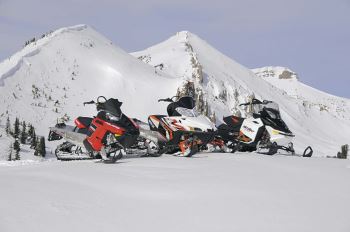 We've been waiting for a year like this one. Maybe for too long. Polaris, Ski-Doo and Arctic Cat all showing up at the game with the best 800 mountain sleds any of them have ever built.
We've been waiting for a year like this one. Maybe for too long. Polaris, Ski-Doo and Arctic Cat all showing up at the game with the best 800 mountain sleds any of them have ever built.
Mountain sleds and riding styles have evolved so far over the past 10-even 5 years-that it's been difficult for one manufacturer to stay ahead of the curve without releasing a new platform every other year. But we feel that for 2011 we've simultaneously got the best technology these three snowmobile manufacturers have to offer.
Arctic Cat's M8, M8 Sno Pro and M8 Sno Pro LE were the best mountain packages of 2010 (they were the best-selling Arctic Cat model of 2010 and some claim the M8 Sno Pro to be the best-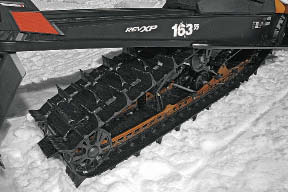 selling sled in the West for 2010 as well) and are in the gun sights of both Ski-Doo and Polaris for 2011.
selling sled in the West for 2010 as well) and are in the gun sights of both Ski-Doo and Polaris for 2011.
Ski-Doo made some major changes to the XP chassis, going for mass appeal with a narrower front end and lighter terrain handling.
Polaris shocked us with a completely re-designed RMK. New front clip (borrowed from the 2010 Rush, but with different geometry), new rear skid, new tunnel, new tank, new body, less weight and an updated engine.
What's new on the 2011 Arctic Cat M8?
A lot changed for the 2011 class of mountain sleds. Not much of it was on the M8, however. For 2011, the M8 gets:
- New ride calibration in the Float rear suspension for a vastly improved ride.
- The base-model M8 gets a coil-over gas rear track shock.
- The LE is replaced with the Sno Pro Limited and it includes a rear storage bag, hand guards, ice scratchers, handlebar bag, goggle holder and BCA storage bag (you had to spring-order for the BCA pack).
- M8 Sno Pro Limited comes in special lime green color.
- New colors and graphics scheme for M8 and M8 Sno Pro.
What's new on the 2011 Ski-Doo Summit 800?
It's a long list. From powerplant to suspension, here's what the 2011 Summit 800 has going on:
- New 800R E-Tec 155-plus horsepower engine.
- Easy throttle pull.
- First-pull starting.
- New 60-volt injectors (compared to the 600 E-Tec's 55-volt injectors).
- New ECU.
- New piston ring.
- 52mm throttle bodies.
- Dual air intake openings.
- Five-chamber muffler.
- New tuned pipe.
- Automatic summarization function.
- Computer-controlled break-in.
- S-36 handling package front suspension with 35.7- to 37.4-inch adjustable ski stance.
- Longer center shock for improved adjustable approach angle.
- Lighter upper A-arm with integrated ball joint; foot traction.
- Pilot DS ski (Summit X) with no outer keel wall, square and flat center keel and a new handle for two-hand pulling.
- New Summit SP model.
- The new PowderMax track is not ported for improved flotation.
- A new windshield deflects snow and air over and away from the driver better than previous designs.
- New colors and graphics.
What's new on the 2011 Polaris 800 Pro RMK?
It's a longer list. The 2011 RMK has a new platform, which means it's the newest model in the class. Here's the DL on the new RMK:
- Engine.
- Updated 2-injector Liberty 800 CFI twin.
- New engine management system designed to resolve the issues some riders had on their 2009 and 2010 800 CFI engines.
- New ECU.
- New regulator.
- New stator.
- New spark plug caps.
- Lower emissions than 2010 800 4-injector CFI engine.
- Improved throttle response.
- Stronger midrange power. Peak power is similar to 2010 800 CFI.
- More consistent performance compared to 2010 800 CFI.
- New fuel rail.
- New fuel injectors.
- New port design.
- Linked oil pump.
- New exhaust system.
- Premium blend/Ethanol blend selector plug.
- Chassis.
- All-new Pro-Ride platform replaces the IQ Raw RMK chassis. The Pro-Ride RMK chassis is an adaptation of the front end of the Rush, but the similarities are fewer than you think.
- Narrow body design.
- Cast front clip.
- 431-lb. dry weight (800 Pro RMK 155).
- Lightweight snow flap.
- Carbon fiber bumper.
- New brake disc.
- New coil-over rear suspension.
- New straight rail beam on 155 skid frame.
- Extruded spindle with a new design that reduces steering effort.
- Steering system that turns tighter with less handlebar movement.
- Walker Evans premium gas shocks.
- New running board tray and edge roll for better snow clean-out and improved traction.
- Aluminum running board bracket and seat support (compared to steel components on 2010 RMK).
- Open-sided toe-hold design.
- Lightweight jackshaft.
- No more Dragon.
- New model 800 RMK LE, a spring-order exclusive. Comes in Turbo Silver color scheme.
What's better about the 2011 Arctic Cat M8?
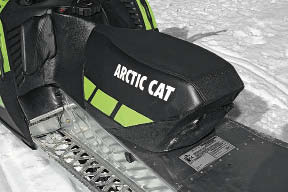 Well, for starters, the 2010 Arctic Cat M8 Sno Pro was our top pick of the 800 class last season. So improving on 2010's changes is a big step. However, none of our test riders were big fans of the 2010's ride quality.
Well, for starters, the 2010 Arctic Cat M8 Sno Pro was our top pick of the 800 class last season. So improving on 2010's changes is a big step. However, none of our test riders were big fans of the 2010's ride quality.
That has changed with the 2011 M8 Sno Pro and Sno Pro Limited. Suspension engineers looked at the valving of the Fox Zero Pro front track shock and the Fox Float rear track shock. New valving specs changed the harsh ride of the Float skid to a much more supple ride. The flat thud factor and the rebound kick are gone and the 2011 Float skid rides as well as anything.
During our time on the 2011 skid, we covered what seemed like hundreds of miles on rough trails, from stutter bumps to severe moguls. Our motto for trails is "The faster you go, the sooner it's over." We could carry speeds through these sections that we couldn't come close to matching on a 2010. How do we know? We had a 2010 in the group on a couple of the test sessions.
The new ride calibration is the biggest improvement to the 2011 M8. And it's huge.
What's better about the 2011 Ski-Doo Summit 800?
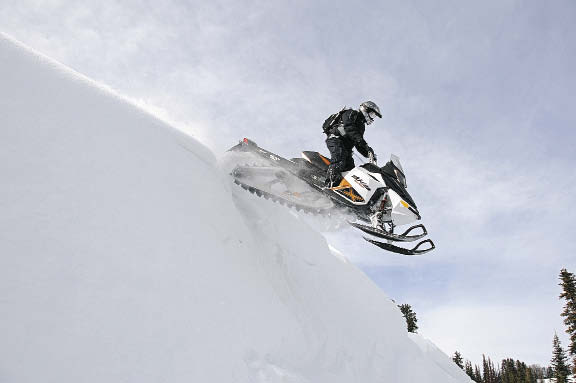 There are a few new things in play that affect the ride characteristics of the 2011 Summit. First is the longer track shock. Last year, Ski-Doo lengthened the rear suspension's front torque arm to help magnify weight transfer. This year, they increased the length of the front track shock to get more travel out of the arm. The move has a pronounced impact on the sled's handling-if you let the limiter straps out. You can get the 2011 Summit 800 to stand up and dance if you want... or at least give it a very light nose feel.
There are a few new things in play that affect the ride characteristics of the 2011 Summit. First is the longer track shock. Last year, Ski-Doo lengthened the rear suspension's front torque arm to help magnify weight transfer. This year, they increased the length of the front track shock to get more travel out of the arm. The move has a pronounced impact on the sled's handling-if you let the limiter straps out. You can get the 2011 Summit 800 to stand up and dance if you want... or at least give it a very light nose feel.
The second factor is the new narrow 36-inch front end. How narrow is a 36-inch stance? The torpedo-looking 1996 Summit 670 had a 37-inch ski stance. The 2011 is slim. But don't think that it will handle like an overly-narrow machine. One of our contentions with the Summit XPs to date has been the overly-stable feel. The 36-inch ski stance makes the sled extremely agile for tight canyon and tree riding. Yet it doesn't feel like it could roll completely over on you at any given moment. The XP chassis is very rigid with a low center of gravity. The 36-inch front end is a good match for Summit models.
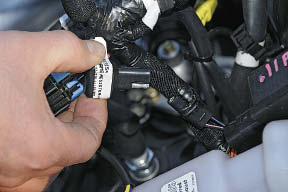 No. 3 on our list is the fuel-injected 800 E-Tec engine. You can catch up on all the tech specs in our September issue, but this engine is cutting edge. And what it brings to the Summit that was previously lacking is lighter throttle pull, easier starting, cleaner emissions, better fuel economy and all without a sacrifice in power. In fact, the E-Tec 800 is stronger in some areas than the Power Tek 800.
No. 3 on our list is the fuel-injected 800 E-Tec engine. You can catch up on all the tech specs in our September issue, but this engine is cutting edge. And what it brings to the Summit that was previously lacking is lighter throttle pull, easier starting, cleaner emissions, better fuel economy and all without a sacrifice in power. In fact, the E-Tec 800 is stronger in some areas than the Power Tek 800.
So if you add it all up, the 2011 Summit 800 E-Tec is really a totally new machine from last year. Aside from the chassis, you get new parts or calibration pretty much everywhere.
Ski-Doo's objective with the 2011 Summit was to gain market share by attracting the crowd of mountain riders who do less steering and more maneuvering through trees and technical mountain terrain. It made the front end lighter by improving weight transfer. It made the sled more agile by narrowing the ski stance. It kept the rear end hp higher in the snow by going to a non-ported track design. The ride package adds up to a feel that responds totally different to the "wrong-foot-forward" riding style, yet maintains its branded XP feel for the guys who like the stable feel.
What's better about the 2011 Polaris RMK 800?
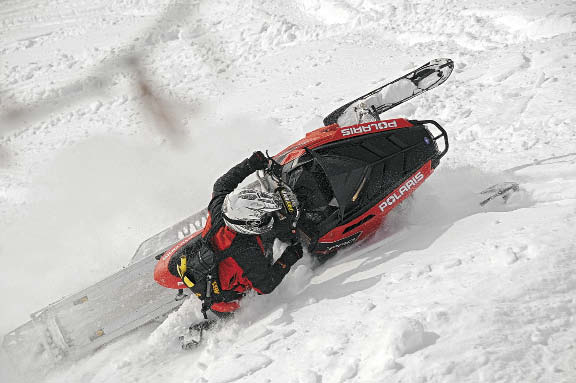 It's an all-new machine. Granted, there is a risk to scrapping a functional platform and going to something totally different. Computer models can fail to live up to real-world conditions.
It's an all-new machine. Granted, there is a risk to scrapping a functional platform and going to something totally different. Computer models can fail to live up to real-world conditions.
The IQ Raw platform that carried the RMK nameplate from 2007 through 2010 (and into 2011 on the 600 RMK) worked, but had its limitations. The track tended to lift and wash out on steep sidehills. The nose pan design didn't float incredibly well. Those and other concerns were used to influence the design of the new Pro RMK platform.
A narrowly-sculpted body (different side panel design than the Rush trail models) keeps the body out of the snow-keeping the track in. You have to be in firm spring snow or completely on your side to lift the track out of the snow now. The front end works with the snow and floats through powder better than before. New running boards clean out snow better. Pay special attention to the new toe holds; there's not a side closure anymore. That gives the snow somewhere to go when you're kicking it out and also lets you get your leg farther forward on the machine for extreme sidehill maneuvers. The 2011 Pro RMK is a better platform than the IQ Raw RMK.
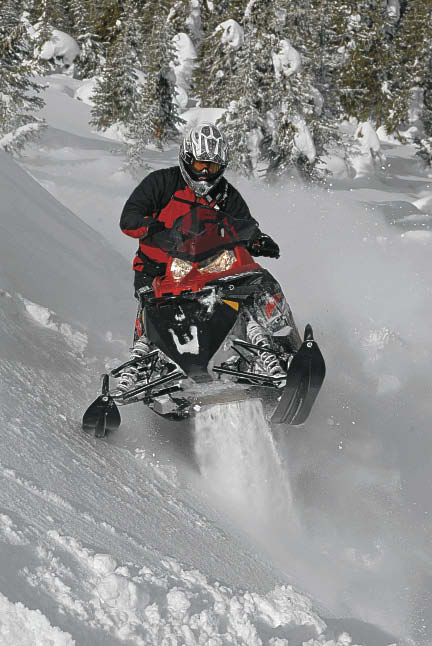 What else is better? We've grilled Polaris over the engine/electrical issues that some 2009 and 2010 800 RMK owners dealt with and they assure us that the issue has been resolved. Polaris went to different sources for its ECU, regulator, stator and spark plug caps. The 2011 800 Cleanfire engine is an improvement on the previous version, with a 2-injector design with new fuel rail and new injectors for cleaner, more consistent operation and stronger mid-range power. The 2011 800 CFI engine feels better on the snow than the old engine.
What else is better? We've grilled Polaris over the engine/electrical issues that some 2009 and 2010 800 RMK owners dealt with and they assure us that the issue has been resolved. Polaris went to different sources for its ECU, regulator, stator and spark plug caps. The 2011 800 Cleanfire engine is an improvement on the previous version, with a 2-injector design with new fuel rail and new injectors for cleaner, more consistent operation and stronger mid-range power. The 2011 800 CFI engine feels better on the snow than the old engine.
Suspension technology has come a long way in the past few years. Polaris is taking a big step forward with its new, fully-adjustable coil-over rear suspension. The design is intended to give the rider more control over suspension settings and chassis attitude in the snow. By adjusting the preload spring tension on the rear track shock, you can quickly change how much transfer the sled has and how the front end acts in the snow. Riders should be able to change settings without any tools for varying snow conditions-whether it's week-to-week or even during one ride.
How do the machines stack up?
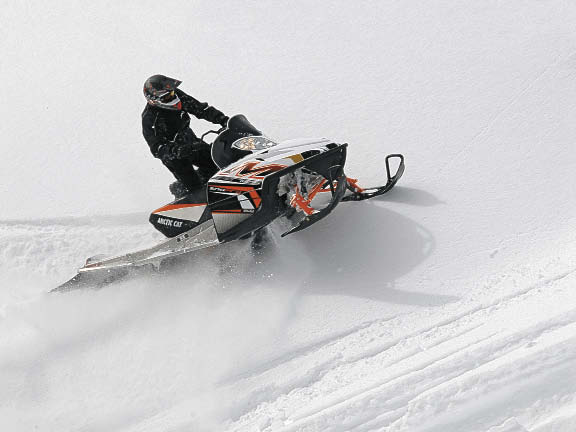 Easy to ask, complicated to answer. Before we get into it, we have to explain something. Mountain riding styles have changed drastically over the past three to five years. And the styles are evolving rapidly. It's more important now to find the sled that best fits your riding style than to try and determine which is the best in the class.
Easy to ask, complicated to answer. Before we get into it, we have to explain something. Mountain riding styles have changed drastically over the past three to five years. And the styles are evolving rapidly. It's more important now to find the sled that best fits your riding style than to try and determine which is the best in the class.
That may sound like a cop out on our part but we've spent a lot of time thinking this over and talking to riders of all brands while watching sledders ride. Riding styles have a great deal to do with how you're going to make each one of these 800s work.
The more traditional approach is what's worked over the past two decades: Turn the handlebars-both skis on the ground-to turn the sled.
The new style is more progressive: Go everywhere essentially on one ski, using throttle and balance to turn the machine.
The new style manipulates every aspect of the machine and rider to control and determine the sled's position on the mountain, angle, speed of descent, etc. It's how riders are flipping U-turns mid-slope, traversing canyon sides through thick tree cover and dropping off ridges without having to commit to the bottom.
Which riding styles is each machine better suited for?
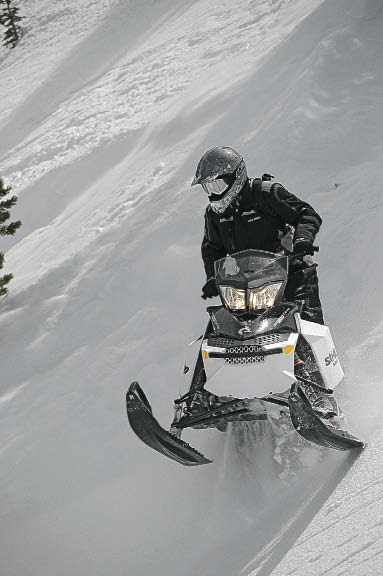 Here's the SnoWest SnowTest staff's opinion on each sled:
Here's the SnoWest SnowTest staff's opinion on each sled:
Arctic Cat M8 - This is the sled that helped develop the progressive riding style. It is very agile and easy to make quick directional changes on-so long as you don't try steering it. Novice riders have complained that it feels too stable and is hard to lean over and doesn't turn very well. Expert riders know that it takes a slight turn out (flick the handlebars in the opposite direction you want to go) to initiate chassis roll and get the sled to carve.
Ski-Doo Summit 800 - In years past, it has been the most stable-feeling of the bunch and best suited for the traditional style. However, for 2011, its spectrum has broadened. While it isn't as easy to flick around and ride cut into a hill as the other two, it does it better than any Summit XP to date. The narrow stance has cost it some stability for the steering crowd, but surprisingly not too much.
Polaris Pro RMK - The new king of progressive riding. This chassis responds instantly to rider input, but it doesn't over-react like the old IQ RMK and it doesn't want to set itself back down to level when you're holding it into a sidehill. The sled stays in the position and attitude that the rider puts it in and can cut more vertical sidehills than the other two simply because the track is not pushed out of the snow by body plastic.
What determines how a sled works for different riding styles?
Handlebar position, foot position, rider body center position and engine location all relative to spindle location. That, along with ski design, suspension function, chassis center of gravity, running boards and approach angle. Like we said, it's complicated. (see page 26)
So what, no pick for class favorite?
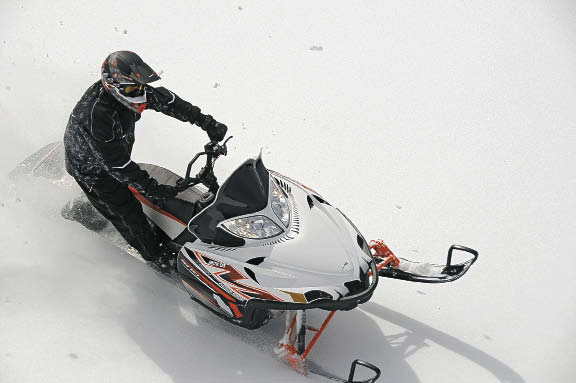 Oh, no-it's not that complicated. The majority of our staff feel that the 2011 Polaris RMK has set a new standard for mountain sled functionality.
Oh, no-it's not that complicated. The majority of our staff feel that the 2011 Polaris RMK has set a new standard for mountain sled functionality.
It's no longer a war over horsepower. Mountain riding has become a skilled trade. And it all comes down to who can build the better tool. Riders are turning away from the steep shootout slopes and finding fun in challenging technical riding. You can spend half a day on a tree-covered short hillside just seeing who can carve the gnarliest line across the side of it instead of up and over it.
Right now, all three models are stellar performers. There's never been a better Summit 800. There's never been a more impressive M8.
But the 2011 Pro RMK gives the rider more ability to manipulate the mountain than any stock mountain machine offered to the snowmobile public.